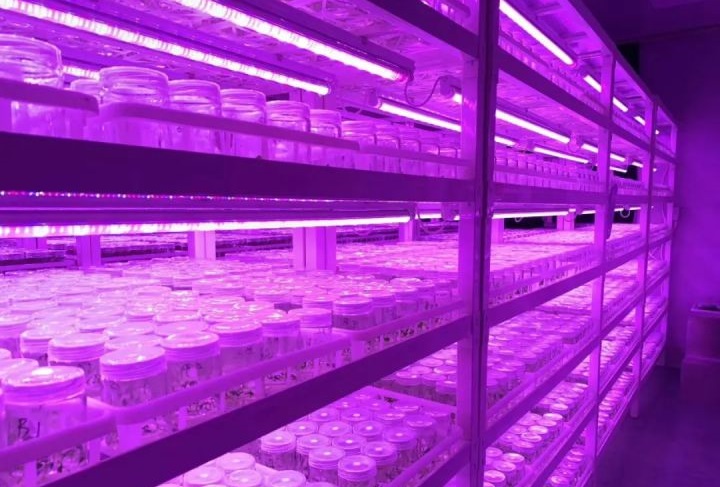Like the nutrients made for cannabis, a proper light system is another essential factor to consider when growing cannabis plants indoors. With the invention of LED lights, these are considered the best hydroponic light sources that can allow cannabis to produce more buds and flowers at high growth rates. Hydroponic LED grow lights are much more energy-efficient when compared to standard halogen, high-pressure sodium (HPS), fluorescent, or metal halide (MH) grow lights. Unlike traditional grow lights, LED grow lights can be specially tuned to the specific spectrum required for a specific growth stage. Cannabis is very sensitive to light, and it is necessary to adjust the light intensity, color, and frequency for each stage of its growth.
Photosynthetically Active Radiation (PAR) is the band of wavelengths between 400nm and 760nm. The PAR band starts from the violet spectrum (380nm to 450nm). This range of light is considered to improve the color, potency, and taste of flowers and does not play an active role in the photosynthesis process. After that, the blue spectrum of light lies between 450 nm and 495 nm, which is very important in photosynthesis and rapid cannabis growth. Light of this color is most often used in the sprout and vegetative stages of growth because it promotes plants' rapid growth and development. After the blue spectrum, wavelengths from 495 nm to 570 nm represent the green spectrum of light. Cannabis plants absorb very little green light energy, but there are reports that small amounts can affect growth. The wavelength of yellow light energy ranges from 570 nm to 590 nm. Although of little importance during photosynthesis, yellow/red light promotes budding and is essential during the flowering stage of plant growth. The final color of the visible light spectrum is red. It has wavelengths in the range of 620 nm to 760 nm. This light is needed during the cannabis flowering period. The addition of red light induces budding and flowering. Many cannabis growers switch to a more substantive red light source when the plant reaches its flowering stage. The red light mixed with blue gets the best response from the cannabis plants.
Higher PAR of hydroponic LED grow lights promote faster plant growth and can lead to larger plants. It has been suggested that light intensity is even more critical than the spectrum. The intensity of the light is measured using the photon flux. Photosynthetic Photon Flux (PPF) indicates how many photosynthetically active photons are being emitted from the light source every second. By knowing the PPF value of the light source, the total light output that contributes to photosynthesis can be found. The unit used to represent PPF is micromol/sec (μmol/s). The effectiveness of PAR is a measure of the amount of photosynthetic light (μmol/J) produced by the illumination per joule of energy used. For indoor cannabis cultivation, energy-efficient lights with high PAR efficiency are recommended.
Moreover, cannabis requires periods of darkness and light at specific intervals for optimal growth. Therefore, hydroponic light systems should be fitted with timers or the internet of things (IoT) based to help growers control the light. The optimal photo-period depends on the particular plant variety and should be investigated before it grows. The indoor cannabis growers tend to buy full-color spectrum lights for plants to maximize their growth and produce more buds and flowers.

With more than ten years of experience in horticultural lighting, VANQ LED provides plants-oriented and cultivation-proved LED grow lights for commercial cultivators and individual hobby growers. VANQ LED grow lights cover a wide range of horticulture applications, such as cannabis/cannabis cultivation, vertical plant factory, tissue culture, supplemental greenhouse lighting, etc. The VANQ LED lights are available in different shapes, PAR, and PPF values. The GLT series is available in the form of grow light bars. GLIC series includes COB LED grow light and GLMX series includes LED grow light covering effective vegetative and flower footprints. All LED lights cover the full spectrum range and can be used according to the indoor cannabis cultivation conditions.
VENQ LED uses top-quality components such as Samsung & Osram LED chips,Meanwell/Inventronics LED drivers, Large size AL6063 Aluminum heat sink, etc. The company owns its R&D department, which is continuously improving the quality of LED grow lights and bringing innovation by carrying out research work involving its agronomy research team and hundreds of professional cultivation partners around the world. VANQ LED is also one of the pioneers who implemented IoT technology into the horticulture lighting industry. Their wireless spectrum-programmable lighting control system allows users to configure a spectrum with 4 independently tunable channels, enabling horticultural researchers to control the light spectrum according to the growth stage of the cannabis plants with unlimited possibilities. VANQ LED grow lights for cannabis/cannabis with an optimized PAR light spectrum can speed up the plants' growth while generating much less heat and saving over 50% of the energy bill comparing to traditional MH and HPS grow lights.























